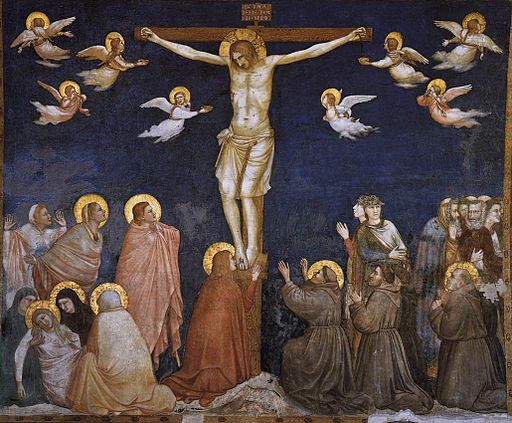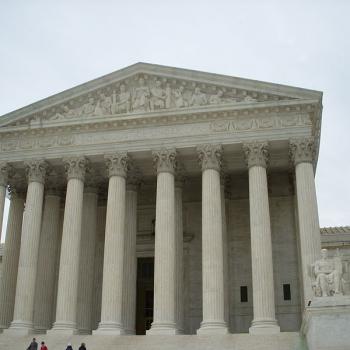Good Friday is traditionally the most somber day of the Christian year. It is the day that the church remembers the crucifixion of Jesus.
Most people think that there is only one way to understand the theological meaning of the crucifixion and the resurrection. Not surprisingly, that way usually corresponds to their own personal belief. This, however, is not true.
Historically, there have been numerous ways of thinking theologically about the meaning of Jesus’ death and resurrection. Theologians refer to these ideas as theories of “atonement.” Since there is a common theme of thinking about Jesus’ life and death in relation to Christians relationship with God, atonement is also sometimes referred to as “at-one-ment” or how Christians come to be “at-one” with God or in relationship with God.
The idea of the monolithic nature of Christian belief is reinforced by the weight, power, and influence of the Roman Catholic church which is structured to concentrate power in the hands of a few authoritative figures who understand themselves to be the voice and wisdom of the Church and thus of Christianity. Other branches of Christianity often share a tradition of hierarchy which often concentrates power in male authority figures (pastors, bishops, elders, etc.). This traditional concentration of power and authority contributes to the belief that the theological ideas and authority of these figureheads represents the “Truth.” This “truth” is also often referred to as “dogma” or “doctrine.”
And yet, different groups of Christians believe different things – about God, about Jesus, about salvation, and what it means to be a Christian and about the meaning of the death and resurrection of Jesus. It can be difficult for some Christians to accept that not all Christians believe the same things about our “common” faith tradition. For people who believe that “Truth” (with a capital “T) is important – this concept is even more difficult.
Here is where knowing Christian history can help people recognize that what is a historical and sociological reality does not have to be theological threat. Few Christians today hold the same beliefs that marked the early church, nor do we worship in exactly the same way. Yes, there are traditions we have inherited – baptism, communion, ordination – but our understanding of these traditions have also changed and evolved over time. This is what it means to be part of a living faith tradition.
In her book, Sisters in the Wilderness, womanist theologian Delores Williams explains that theologians have always used the language and sociopolitical thought of their era to help people make sense of Christian ideas and principles. She illustrates this point by outlining four theories of atonement that have dominated different eras of Christianity. Let’s look at them briefly:
Ransom theory– this early theory of atonement held that humans were indebted to the devil and that Jesus’ death on the cross represented a ransom that God paid to reclaim humans from Satan.
Satisfaction theory – this theory held sway in the Middle Ages when the idea of “honor” was prevalent. It was thought that people owed honor to God as serfs owed honor and loyalty to the landowners. Human sin was regarded as dishonoring God, codes of chivalry required that God be “satisfied” for this dishonor but humans were incapable of offering adequate satisfaction. Christians believed that God offered Jesus up as “satisfaction” to right the wrong of human sin.
Moral theory – A competing atonement theory in the Middle Ages promoted the idea that when people viewed Jesus’ death on the cross as an expression of God’s great love for humanity it evoked an internal transformation that prompted people to seek forgiveness and reconciliation with God.
Substitutionary – The Renaissance and Reformation ushered in a new way of thinking about reconciliation with God. A revived interest in ancient law and divine justice prompted the Reformers to focus on the need for punishment for human sin. The Reformers’ equal interest in God’s mercy ushered in an atonement theory that viewed Jesus as a “substitution” for the punishment that was necessary to atone for human sin. In this theory, Jesus bore the necessary punishment for human sin so that humanity needn’t suffer.
I grew up with elements of all of these theories of atonement sprinkled throughout the hymns, creeds, sermons, and catechisms that shaped my spiritual formation. For many Christians, our theology is a hodge-podge of ideas that we gather together in our own idiosyncratic way as we mature and grow into our faith.
But at some point, these traditional ways of thinking about Jesus’ death and resurrection failed to make any sense to me. At all. Our historical moment is different, it influences how we think about faith and God.
Traditional atonement theologies are rife with violence – state-sanctioned violence (the Roman empire killed Jesus); child abuse (God killed his son); sacrificial violence (reconciliation requires self-sacrifice). When I realized the way in which Jesus’s crucifixion has too often been a celebration of violence, I stopped wearing crosses as jewelry. My life and my faith are oriented toward challenging the power and use of violence in society and in our faith as justification for anything. Thinking about Jesus’ death as “necessary” for my salvation was almost enough to make me leave the church. Almost.
Feminist, womanist, mujerista and other critical theologies saved Christianity for me.
As a progressive Christian feminist and an ordained Presbyterian minister, I know that the salvific power of Christianity lies in the message that Jesus shared in the life that he lived. As a womanist theologian, Williams illustrates the way in which womanist/feminists/mujerista theologians have offered new and more relevant was of thinking about salvation and crucifixion. Williams talks about how Jesus’ life offers us a new “ministerial vision.” What she means is that it was Jesus life and ministry that offered a vision of how to establish right relations between people and between us and God. It was this new vision for “positive, abundant relational life” that Jesus offers to his followers as a way of salvation. Williams argues that “Jesus therefore conquered sin in life, not in death.”
This Good Friday, I remember that for too many people the struggle to assure that all of God’s people have access to Jesus’ vision of positive, abundant relational life is a threat to the powers that be and that following this path can be dangerous.
When I gather together this evening with friends, I will remember Jesus’ words that whenever two or three of you are gathered together – I am with you. And we will drink a toast to Jesus’ life.













